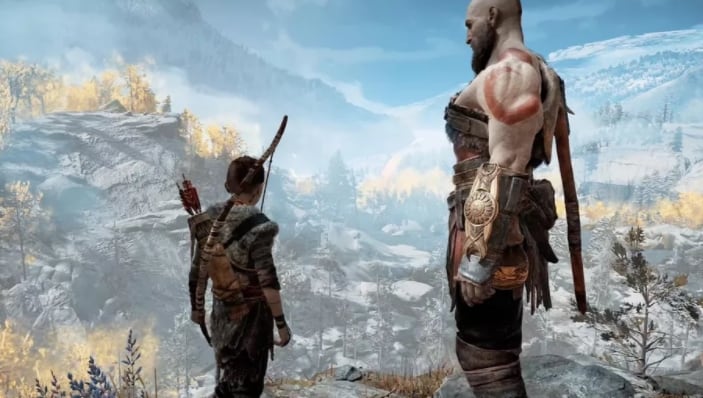
God of War is still a God of War game, but it isn’t like the others.
Kratos is back, but he’s an older, more reserved expat, and the game (and gameplay) evolved along with him. It’s not that you’ll be playing something completely novel — Kratos is still angry (spoiler?) and tends to murder everything — but there are some pretty big changes in style and gameplay. Here are the biggest ones you’ll see in God of War.
IT’S AN OPEN-WORLD GAME
The biggest difference is the setting. You’re no longer in ancient Greece. Kratos is in exile, living in a generically Scandinavian country. That means a whole new mythology of monsters to tear apart and meddling gods to deal with. But it’s not just different for different’s sake. The new setting is vibrant and alive. And it’s full of interesting things to find.
Instead of the more linear hack-n’-slash of the previous entries in the series, God of War now emphasizes and rewards exploration. You’re free to travel and explore (basically) anywhere at any time — and there’s a lot of world to explore. What’s more, the game’s single-take seamless approach to visual storytelling means that each of the areas you explore flows from the last. There are no load screens to eject you from the narrative. Sure, some areas are gated — either physically or by tough enemies — but your exploration never goes unrewarded.
Even in the most straightforward point-A-to-point-B areas, there are branching paths to explore. Every time you take one of the wrong turns, you’ll be rewarded with things like chests or useful items.
/cdn.vox-cdn.com/uploads/chorus_asset/file/10640309/god_of_war_differences__0003_puzzle.jpg)
Within the larger world and the regions you explore, the level design is a lot more complex, too. Running around and exploring involves a lot of verticality, puzzles that open new pathways, and shortcuts that take you to unexpected places.
An open world means side quests, too. Instead of single-mindedly seeking out gods to punch in the face, Kratos now has the option to help out the denizens of his new homeland. These favors are optional, and you can take them on whenever you want. They’ll earn you extra experience, gear and cash. And that’s all important because …
IT’S AN ACTION RPG
You’ve always been able to customize Kratos’ abilities to an extent — like which combo to unlock next — but God of War allows much, much more. You have control over Kratos’ stats now.
/cdn.vox-cdn.com/uploads/chorus_asset/file/10640311/god_of_war_differences__0005_rpg.jpg)
Kratos’ armor, enchantments and weapon mods all bear their own stats and modifiers, so you can customize him to your preferred style of play. If you like the Rambo approach, you can equip gear that increases his raw strength. Or you can play defensively and focus on those stats instead. Your equipped gear drives it all.
Story progression and a new crafting mechanic unlock new gear. The loot you pick up becomes new gear with (hopefully) better stats. And that, in turn, lets you take on new areas and new enemies.
All of that means that there’s a lot more to manage. It’s not just about swinging blades real good anymore. Kratos is more than a mindless killing machine, and God of War’s mechanics reflect that.
/cdn.vox-cdn.com/uploads/chorus_asset/file/10640313/god_of_war_differences__0002_ranged_combat.jpg)
COMBAT IS NUANCED
Kratos’ evolution and the new, expanded design philosophy extend to the combat as well. Fighting in God of War is less about mowing down crowds of enemies on your way to battle a boss, and more about tactical, careful approaches to smaller, tougher groups of enemies.
The biggest change to combat is your weapon. Gone are the iconic Blades of Chaos. Kratos now wields a (magical) axe. That moves a lot of the action up close. But Kratos can also throw his axe, which adds a new ranged combat element (and headshots) to the game.
Also gone are the quick-time events from the previous games. Now, when you finally beat a school bus-sized monster into submission, you don’t have to worry about making sure to hit the right sequence of buttons to finish it off. Instead, you watch your enemy’s stun gauge, hit one button, then just sit back and let the brutality unfold.
NEW GAME, NEW KRATOS
Kratos will always be Kratos. He’s a grumpy old Spartan who’s led a rough life. He’s not going to become jovial just from a change of scenery, but neither is he the exact same murder-man we have grown to, if not love, at least tolerate.
/cdn.vox-cdn.com/uploads/chorus_asset/file/10640321/god_of_war_differences__0000_pensive.jpg)
Kratos made a new life for himself in Scandinavia. He’s got a new home, a new weapon and a new family. Nothing is perfect (and things only get worse), but he’s clearly changed. In God of War, we get to see Kratos struggle not only with supernatural forces, but internal, emotional forces as well.
And that internal struggle is personified.
KRATOS IS NOT ALONE
The final huge departure in the new God of War is Kratos’ constant companion. His son, Atreus, is always by his side. But that doesn’t mean that the game is one long escort mission (shudder).
/cdn.vox-cdn.com/uploads/chorus_asset/file/10640325/god_of_war_differences__0004_the_boy.jpg)
Atreus (or, “the boy”) is an active participant in the adventure. He has his own fighting abilities and personality. In combat, he’s a constant help, never a hindrance — you don’t have to micromanage him or really pay much attention to him at all. While he’s ever-present, he almost fades into the background. He’s there when you need him, and you’ll never find yourself waiting for him or wondering where he’s stuck.
Atreus’ presence makes Kratos different. Kratos now has someone to talk to (well, someone who mostly talks at him) and someone there to help him. Their dynamic turns every scene where you’re just walking or climbing or riding for minutes on end into an opportunity for character development.
And that might be God of War’s biggest change yet: Kratos isn’t trying to become a god to punch other gods in their collective faces — he’s trying to become a better man.
